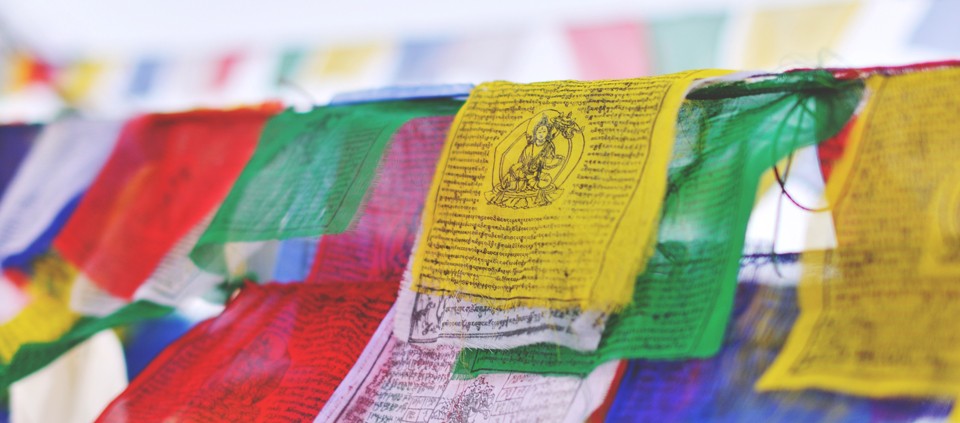Blowing in the Wind: The Sacred Symbolism of Prayer Flags

I have a treasured photograph with an ocean backdrop, the Maine waves dazzled by sun. In the foreground, a stranger’s laundry line cuts a diagonal stripe. The clothes have been assembled in rainbow order, someone’s faded red t-shirt captured mid-flap.
This sight—laundry waving on the line—has had a calming effect on me since childhood. I like the jumbled order, the combination of haphazard wind and deliberate pinning. Laundry was my self-appointed chore as a kid, something I could do without supervision. My thoughts wandered freely, my busy hands sorting and folding, a meditation-in-motion long before I understood what that was. In winter, I enjoyed the new heat of the clothes, sprung from the dryer. I’d sink my face into the hot pile, soothed. But best, in warm months, was the sight of my offering on the line.
Last spring, while placing a prayer flag between two posts on my deck, I began to make the connection. I guess I like to see the inanimate made animate, aspirations made tangible. Now I raise my blinds and see the flags, first thing. I sometimes spot small paper flags in car windshields, in office cubicles, and I realize how little I know about their derivations.
Prayer flags originated in India, as Buddhist sutras written on banners. In the fourth century BC, they were incorporated into Tibetan Buddhist practice. When placed outdoors, according to tradition, the prayer flags initiate peace and good tidings, their sacred mantras etched on the wind. There are two styles: lung ta (“wind horse” in Tibetan) are horizontal; vertical flags are called darchor (dar meaning “to increase life, fortune, and health” and cho meaning “all beings”).
The flags usually come in groupings of five, each flag a different shade, each shade representing an element and arranged from left to right. Blue is sky/space, white is air/wind, red is fire, green is water, and yellow is earth. This combination is said to create a balanced mindset. Like laundry items, grouped by color.
Unlike my Smartwool socks, the flags are crowded with symbolism. They contain a “ta” (horse), which signifies “the speed and transformation of bad fortune to good.” The horse has three jewels on its back, which represent the Buddha, the dharma (teachings), and the sangha (community), the three touchstones of Tibetan practice. The flags may also contain mantras, each devoted to a different deity, and, in the corners, images of four mighty animals (also known as the Four Dignities): the dragon, the garuda (a mythological, eagle-like bird), the tiger, and the snow lion.
These complex designs were originally painted by hand, one at a time, says Timothy Clark, founder of Radiant Heart Studios, where he collects, draws, and prints prayer flags. He explains that woodblocks, carved in mirror image relief, were introduced in the 15th century. This made it possible to reproduce identical prints, which could then be passed down from one generation to the next.
Skilled Tibetan woodblock carvers, often monks or lamas, continue to make prayer flag blocks as a spiritual practice, says France Robinson of West Wind Flags. Most prayer flags imported from Tibet are still woodblock printed. Those made in North America tend to be made from silkscreens.
Because they contain sacred symbols, refrain from putting prayer flags on the ground or in the garbage, Timothy advises. When disposing of old flags, the customary Tibetan method is to burn them. The smoke can then carry the flags’ final blessings to the winds.
Such blessings aren’t meant to benefit the individual, he says. The flags are positioned, ideally, for the sake of others. (I remember my working parents, grateful for the clean bundles on their bed.)
In 2016, I was delighted to see Joan Farrenkopf’s take on this tradition, when her outdoor art installation, Inspirare, was on view on Kripalu’s Mansion Lawn: mammoth prayer flags of black, white, yellow, red, and turquoise. “The active canvas moves and merges with the elements of sun, rain, wind, and darkness, revealing a mix of color and light,” says Joan. Inspirare was conceived in response to violent news events and represents her hope that “art can guide us through the turmoil of our times. It signifies a return to peaceful resolution, to a state of balance.”
On a mild July day, I took my writing class just beyond the Mansion Lawn to watch the flags soar. One cloth edge got tangled on the line. The slow flapping was like a laundered sheet. All that possibility, gorgeous in its imperfect placement, high above our heads.
Lara Tupper teaches, writes, sings, and launders in the Berkshires. laratupper.com
© Kripalu Center for Yoga & Health. All rights reserved. To request permission to reprint, please e-mail editor@kripalu.org.
Lara Tupper, MFA, is the author of two novels, Off Island and A Thousand and One Nights, and Amphibians, a linked short story collection forthcoming in 2021.
Full Bio and Programs